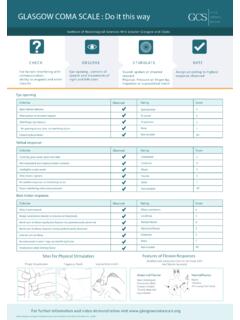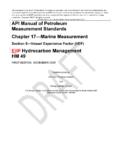Transcription of The Modified Glasgow Coma Scale - bvns.net
1 What is the MGCS?The Glasgow Coma Scale (GCS) was created in 1974 by Graham Teasdale and Bryan Jennett as an objective way to assess the level of consciousness in humans with traumatic brain injury and coma at initial and subsequent evaluations. This Scale was Modified for veterinary use by Andy Shores, Chief of Neurosurgery and Neurology at the Mississippi State University College of Veterinary Medicine, in 1983. Along with the Small Animal Coma Scale (SACS), the Modified Glasgow Coma Scale (MGCS) was proposed as a means of objectively evaluating the neurological status of dogs after traumatic brain injury.
2 The score is a useful way to monitor progression of neurologic deficits, effects of therapeutic measures and to assess overall MGCS is performed following a neurologic examination and is an objective way to evaluate neurologic function. It is comprised of three categories: motor activity, brainstem reflexes and level of consciousness. Each category is scored 1-6 with 1 ibeing indicative of more severe dysfunction. The scores from each category are added together to establish a coma score. See table below for the particulars of the Glasgow Coma ScaleSCOREM otor ActivityNormal gait, normal spinal reflexes6 Hemiparensis, tetraparesis, or decerebrate rigidity5 Recumbent, intermittent extensor rigidity4 Recumbent, constant extensor rigidity3 Recumbent, constant extensor rigidity with opisthotonus2 Recumbent, hypotonia of muscles.
3 Depressed or absent spinal reflexes1 Brainstem ReflexesNormal PLR and oculocephalic reflexes6 Slow PLR and normal to reduced oculocephalic reflexes5 Bilateral unresponsive miosis with normal to reduced oculocephalic reflexes4 Pinpoint pupils with reduced to absent oculocephalic reflexes3 Unilateral, unresponsive mydriasis with reduced to absent oculocephalic reflexes2 Bilateral, unresponsive mydriasis with reduced to absent oculocephalic reflexes1 Level of ConsciousnessOccasional periods of alertness and responsive to environment6 Depression or delirium, capable of responding but response may be inappropriate5 Semicomatose, responsive to visual stimuli4 Semicomatose, responsive to auditory stimuli3 Semicomatose, responsive only to repeated noxious stimuli2 Comatose.
4 Unresponsive to repeated noxious stimuli1 MCGS ScoreSCORE3-8grave9-14guarded15-18goodA publication for technicians by our Modified Glasgow Coma ScaleCopyright 2016 Bush Veterinary Neurology Service. All Rights Reserved. 0920 Thank you to the staff of BVNS Springfield and Dr. Sarah Trub for collaborating on this you should expect from BVNS when you refer a case: Faxed Referral Letter (with call to confirm receipt). Desire to discuss any case, whether it is a referred case or a consultation. Dedication to provide superior service to you and your more information on services offered, please visit us at available.
5 Call now to of the Coma ScaleIt is good practice to use the MGCS on any patient that we encounter, but it is best utilized in patients with changes in level of consciousness (dull, obtunded, stuporous, comatose) or a recent history of head trauma. In these patients, the Scale becomes a useful indicator of the severity and progression of neurologic dysfunction and may be a helpful prognostic indicator. As a patient s condition can rapidly change, the MGCS can be performed throughout the patient s hospital stay to help guide the medical team in treatment decisions and better communicate prognostic information to the of Scale UseIn veterinary medicine, the MGCS is best known for evaluating severity of brain injury, progression of the injury, effects of therapy and predicting prognosis following head trauma and traumatic brain injury (TBI).
6 This scaling system has been shown to have prognostic applications in canine head trauma patients (Platt et al. 2001; Sharma and Holowaychuk 2015). Prognosis improves with higher scores and declines with lower scores with 50% mortality (related to head injury) in the first 48 hours with a score of 8 (Platt et al. 2001). In fact, the MGCS has been shown to be the best predictor of survival when compared to the Animal Trauma Triage (ATT) Score and multiple clinicopathologic parameters, with a MGCS of <11 having a sensitivity of 84% and specificity of 73% for predicting non-survival to hospital discharge (Sharma and Holowaychuk 2015).
7 Future DirectionsSmartphone technology has made it easier for veterinarians to find and share information. In 2014, a Small Animal Coma Scale App was created by Andy Shores. Veterinarians can use the app to score a patient and later submit patient outcome in reply to a follow up email. This app will facilitate a large collection of data regarding patient outcome so that we may better understand how different aspects of the scoring system contribute to Modified versions of the MGCS are also in the process of being validated.
8 One of these, under development by Simon Platt, is being utilized by Bush Veterinary Neurology Service in a clinical study to evaluate whether this Scale may yield prognostic information for dogs with meningoencephalitis of unknown etiology (MUE), a common and devastating disease of the central nervous ThoughtThe MGCS can be implemented as an extension of the neurological examination to more objectively determine progression of signs in patients with brain dysfunction. This information helps the veterinarian make better treatment decisions and, in cases of head trauma, prepare the owner with prognostic Platt, SR, Radaelli, ST and McDonnell, JJ.
9 (2001). The prognostic value of the Modified Glasgow Coma Scale in head trauma in dogs. Journal of Veterinary Internal Medicine, 15(6), Sharma, D and Holowaychuk, M. (2015). Retrospective evaluation of prognostic indicators in dogs with head trauma: 72 cases (January-March 2011). Journal of Veterinary Emergency and Critical Care, 25(5), Shores A. Craniocerebral trauma. In: Kirk RW, ed. Current Veterinary Therapy X. Philadelphia, PA: WB Saunders; 1983:847 85






